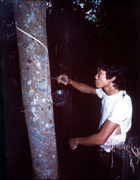Hevea brasiliensis
| Rubber Tree | |
|---|---|
 |
|
| Scientific classification | |
| Kingdom: | Plantae |
| Division: | Magnoliophyta |
| Class: | Magnoliopsida |
| Order: | Malpighiales |
| Family: | Euphorbiaceae |
| Subfamily: | Crotonoideae |
| Tribe: | Micrandreae |
| Subtribe: | Heveinae |
| Genus: | Hevea |
| Species: | H. brasiliensis |
| Binomial name | |
| Hevea brasiliensis Müll.Arg. |
|
The Pará rubber tree (Hevea brasiliensis), often simply called rubber tree, is a tree belonging to the family Euphorbiaceae and the most economically important member of the genus Hevea. It is of major economic importance because its sap-like extract (known as latex) can be collected and is the primary source of natural rubber.
Contents |
Rubber tree plantation
In the wilderness, the tree can reach a height of up to 144 feet (44 m). The white or yellow latex occurs in latex vessels in the bark, mostly outside the phloem. These vessels spiral up the tree in a right-handed helix which forms an angle of about 30 degrees with the horizontal, and can grow as high as 45 ft.
In plantations, the trees are kept smaller, up to 78 feet (24 m) tall, so as to use most of the available carbon dioxide for latex production.[1]
The tree requires a climate with heavy rainfall and without frost.[1] If frost does occur, the results can be disastrous for production. One frost can cause the rubber from an entire plantation to become brittle and break once it has been refined.
Harvest of latex
Once the trees are 5–6 years old, harvesting can begin: incisions are made orthogonally to the latex vessels, just deep enough to tap the vessels without harming the tree's growth, and the sap is collected in small buckets. This process is known as rubber tapping. Older trees yield more latex.

History
The Pará rubber tree initially grew only in the Amazon Rainforest. Increasing demand and the discovery of the vulcanization procedure in 1839 led to the rubber boom in that region, enriching the cities of Belém and Manaus. The name of the tree derives from Pará, the second largest Brazilian state, whose capital is Belém.
These trees were used to obtain rubber by the Olmec people of Mesoamerica as early as 3600 years ago. The rubber was used, among other things, to make the balls used in the Mesoamerican ballgame. There had been an attempt made, in 1873, to grow rubber outside Brazil. After some effort, twelve seedlings were germinated at the Royal Botanic Gardens, Kew. These were sent to India for cultivation, but died. A second attempt was then made, some 70,000 seeds being smuggled to Kew in 1875, by Henry Wickham, at the service of the British Empire [2][3][4][5]. About 4% of these germinated, and in 1876 about 2000 seedlings were sent, in Wardian cases, to Ceylon, and 22 sent to the Botanic Gardens in Singapore. Once established outside its native country, rubber was extensively propagated in the British colonies. Rubber trees were brought to the botanical gardens at Buitenzorg, Java in 1883.[6] By 1898, a rubber plantation had been established in Malaya, and today most rubber tree plantations are in South and Southeast Asia and some also in tropical West Africa.
Efforts to cultivate the tree in South America (Amazon) were unsatisfactory, because of blight.[1]
Synonyms
The genus Hevea is also known as:
- Caoutchoua J.F.Gmel.
- Micrandra Benn. & R.Br.
- Siphonanthus Schreb. ex Baill.
- Siphonia D.Richard ex Schreb.
- Siphopnicna F.Jansen ex Schreb.
See also
- Castilla elastica - the principal source of latex rubber among the pre-Columbian MesoAmerican peoples
- List of plants of Amazon Rainforest vegetation of Brazil
- Rubberwood
Gallery
|
Leaves of a Pará rubber tree |
 Mindanao, Philippines, plantation worker |
 Rubber tree seeds |
References
- ↑ 1.0 1.1 1.2 "Elastomer-The rubber tree", Encyclopaedia Britannica, 2008
- ↑ "The Brazilian Armed Forces: Current changes, new challenges", Dreifuss, R. Armand. International Seminar Research Committee Armed Forces and Society, Romenia, 2002. Retrieved August 19, 2009 from http://www.nestbrasil.com/rest/page8/files/rested1-dreyfus.pdf (p. 55)
- ↑ "Amazon - The Animation", Greepeace Digital. Artificial Environments, n/d. Retrieved August 19, 2009 from http://www.ae-pro.com/preview.php?preid=31&pro=Amazon
- ↑ "Seringueira", Wikipédia, a enciclopédia livre, 2009. Retrieved 11h05min, August 19, 2009 from http://pt.wikipedia.org/w/index.php?title=Seringueira&oldid=15936263
- ↑ "Acre: História e etnologia", Marco António Gonçalves (Org.). Núcleo de Etnologia Indígena Laboratório de Pesquisa Social/IFCS - UFRJ, n/d. Retrieved August 19, 2009 from http://eduardoeginacarli.blogspot.com/2007_07_01_archive.html
- ↑ Winchester, Simon (2003). Krakatoa: The Day the World Exploded, August 27, 1883. HarperCollins. pp. 223–224. ISBN 0-06-621285-5.
Further references
- Zhang, J., Huss, V.A.R., Sun, X., Chang, K. and Pan, D. 2008. Morphology and phylogenetic position of a trebouxiophycean green algae (Chlorophyta) growing on the rubber tree, Hevea brasiliensis, with the description of a new genus and species. Eur. J. Phycol. 43(2): 185 - 193.